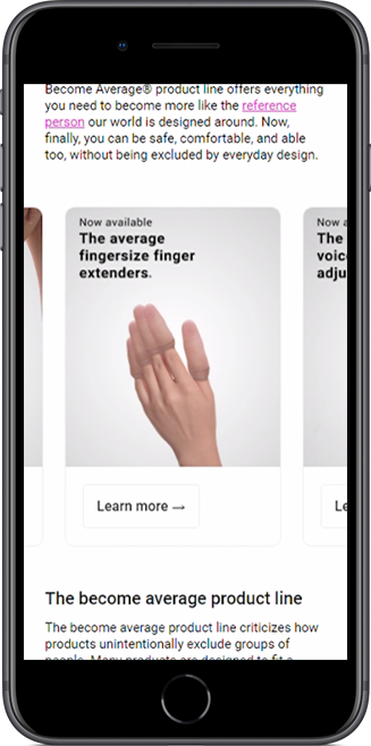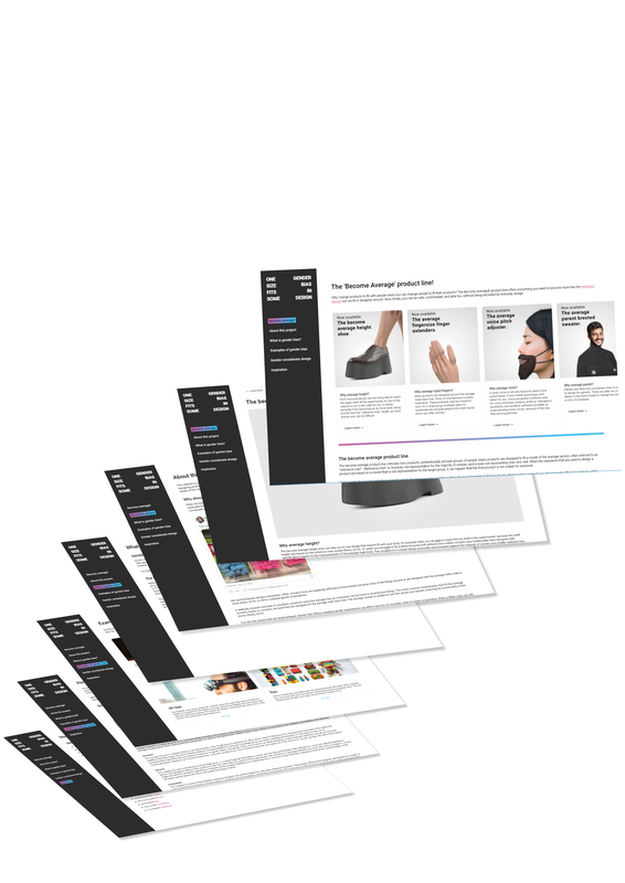Why does voice recognition software work better for men? Why are public diaper changing tables mostly located in the women’s toilets? Why is driving a car much less safe for women compared to men? This is the result of gender bias in design. This project explores this phenomenon.
|
I want designers to become more aware of the role of gender and sex in design so that they might create more inclusive products and services |
In short
|
When thinking about inclusive design most of us don't think about gender. Most products and services are framed as unisex, although in reality they don’t work as well for women as they do for men, or vice versa. Not considering gender and sex in design can lead to products that are inconvenient, or even dangerous to use. A relatively innocent example of this can be found in the physical design of smartphones - ones that are too large for women’s hands (and pockets) as they are based on the average male hand size.This also applies to software design, where female voices are less likely to be accurately processed by voice recognition software and artificial intelligence assistants, like Siri or Alexa, because these programs are trained on datasets in which women are underrepresented. Gender biased design affects men too. When a father goes out with his baby, changing the baby’s nappy can be difficult as changing tables are often only available inside the women’s toilets. This is a result of design choices based on old-fashioned gender stereotypes. When looking at car design, the situation becomes more serious: car safety is tested with crash test dummies based on a model of the average white male. Due to the differences in size and physique of men and women, a woman is 47% more likely to be seriously injured and 17% more likely to die when involved in a car crash. These are just a few examples of gender bias in design, meaning design that excludes men or women based on their physical differences or cultural stereotypes and expectations. It is necessary for designers to increase their focus on the role of gender and sex in design in order to avoid more examples of products that unintentionally exclude half of the population, or even put them in danger. |
|
The "Become Average" advertising campaign
The result of this project is the “Become Average” advertising campaign. This campaign offers a product range that helps everyone to become the ‘average person’ that products and services are designed for. These fictional products emphasize the absurdity of gender-biased design.
The product line is advertised on four posters that are designed to capture the attention of designers and design students, and guide them to a website via a QR code.
On this website visitors can learn more about gender bias, find a database of examples of gender-biased products and services, but also find links to inspirational projects. Aditionally, visitors can learn about the three categories of gender-biased design, and the resulting three focus points for a more gender and sex aware design process.
Through the attention that the “Become average” campaign has received, a greater number of people, including designers and design students, have become aware of the importance of gender-considerate design.
Young designers are the decision makers of the future, getting gender-considerate design on their radar will hopefully lead to products and services that work better for men as well as for women. This project has been able to provide them with examples and tools to guide them in the first steps towards a more gender-inclusive design approach.
Do you want to know more about gender bias in design? Visit www.genderbias.design
The product line is advertised on four posters that are designed to capture the attention of designers and design students, and guide them to a website via a QR code.
On this website visitors can learn more about gender bias, find a database of examples of gender-biased products and services, but also find links to inspirational projects. Aditionally, visitors can learn about the three categories of gender-biased design, and the resulting three focus points for a more gender and sex aware design process.
Through the attention that the “Become average” campaign has received, a greater number of people, including designers and design students, have become aware of the importance of gender-considerate design.
Young designers are the decision makers of the future, getting gender-considerate design on their radar will hopefully lead to products and services that work better for men as well as for women. This project has been able to provide them with examples and tools to guide them in the first steps towards a more gender-inclusive design approach.
Do you want to know more about gender bias in design? Visit www.genderbias.design


